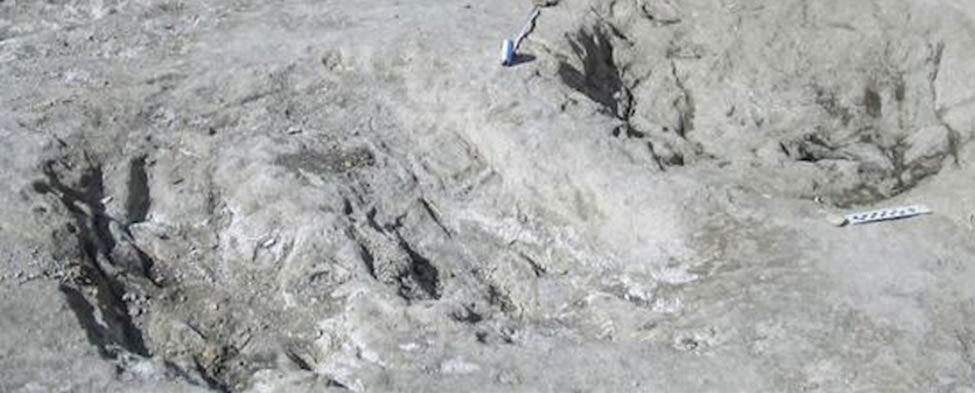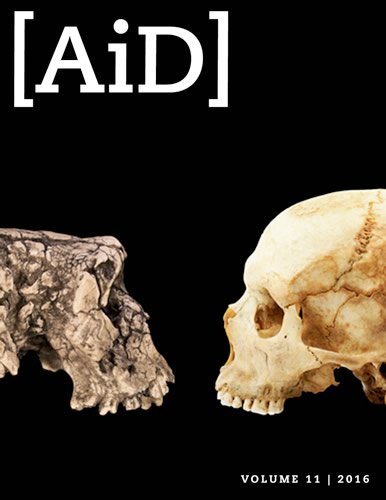
Do Fossilized Theropod Scrapes Reveal Dinosaurs Danced for Mates?
News to Know
Abstract
Is courtship dancing really the “best fit” for these fossilized theropod foot scrapes, or is this scientists’ evolutionary flight of fancy comparing dinosaurs with birds all wet?
News Sources
- Science: “Dinosaurs May Have Danced Like Birds To Woo Mates”
- Fox News: “Dinosaurs May Have Performed Bird-Like Dances To Attract Mates”
- The Huffington Post: “Dinosaurs May Have Danced Like Lovebirds To Woo Their Mates”
Newly discovered dinosaur tracks in Colorado’s fossil-rich Cretaceous rock preserve evidence of frenzied activity. As with most fossilized foot markings, these prints and scratches were not made by dinosaurs carefully placing their feet in cement like Hollywood stars, but by active animals. And the abundance, arrangement, and shapes of these tracks suggest these theropod trackmakers were particularly stirred up. But what were they stirred up about? Paleontologist Martin Lockley, who discovered and analyzed the tracks, has some very definite ideas about that.
The Dinosaur Whisperer
Lockley, in the journal Scientific Reports, describes large random groupings of six-foot-long scrapings gouged 8–12 inches deep into Colorado’s Dakota Sandstone. Most consist of parallel scratches with a raised ridge between furrows. Some show the three-toed footprints of their clawed bipedal printmakers, possibly the 16-foot-long theropod Acrocanthosaurus. Though fossils do not dance, Lockley sees in these dugouts from the past the ritualized mating dance of ancient T. rex-like theropods. Why? Because some ground-dwelling birds today dance to attract their mates, and Lockley (like most evolutionists today) believes birds evolved from dinosaurs.
Lockley found groups of fossilized gouges at four Colorado sites. The largest featured about 60 grooved scrapes on an exposed surface area of about 750 square meters (over 8,000 square feet). He has preserved the visible fossil record of these dinosaurs’ activities using 3D photographic images1 and casts. The tracks have been unroofed by erosion after their long-ago burial and fossilization, supposedly around 100 million years ago. Fossilized ripple marks attest to the movement of water associated with the activity of the theropod trackmakers or of the process that preserved their tracks.

These are some of the six-foot-long scrapes that Dr. Martin Lockley, a University of Colorado Denver geology professor, found fossilized in Colorado. Claw marks gouge the ground to a depth of 8 to 12 inches, and there are raised ridges between the deep scratches. These theropod tracks are fossilized in the Dakota Sandstone, a Cretaceous formation hosting many fossilized footprints. Screen shot of photograph provided by Martin Lockley published in Fox News.
Looking at the footprints, Lockley says they “went crazy scraping. These animals would have been really frenzied.”2 He believes that the best explanation for these fossilized tracks is a mating dance and that the groupings represent arenas in which these ritualized dances were performed. “These are the first sites with evidence of dinosaur mating display rituals ever discovered, and the first physical evidence of courtship behavior,” says Lockley. “These huge scrape displays fill in a missing gap in our understanding of dinosaur behavior.”3
Connecting the dinosaurs’ behavior to that of their supposed evolutionary descendants, Lockley says, “The scrape evidence has significant implications. This is physical evidence of pre-historic foreplay that is very similar to birds today. Modern birds using scrape ceremony courtship usually do so near their final nesting sites. So the fossil scrape evidence offers a tantalizing clue that dinosaurs in ‘heat’ may have gathered here millions of years ago to breed and then nest nearby.”4
Dancing With Dinosaurs
But could these theropods have been doing something besides performing for a potential mate? Lockley maintains that all other options have been ruled out. The gouges were not nests, he concludes, because there is no evidence of eggs, eggshells, nest rims, or hatchlings.
Could they be territorial markings? Lockley notes that some mammals, especially cats, mark territory with urine sprinkled digs, but he believes that the dinosaurs could not have so marked their territory because reptiles and birds typically excrete a pasty compound containing uric acid instead of more fluid urea-containing urine and would therefore be unable to label their scraped-out ditches as cats do.
Could the theropods have been digging prey out of the ground? Lockley excludes that option because he says pursuit of prey would have produced deeper holes, holes that would have caused water to pool and wash the tracks away before they could be preserved. Besides, the scientists haven’t found burrows belonging to any sort of animal delicacy.
In the face of all this negative evidence, Lockley concludes that a ceremonial mating dance is the only reasonable option. In Scientific Reports, Lockley then describes the “source” of the positive scientific evidence supporting his story:
Turning to the fourth hypothesis, that the scrapes represent display arenas containing evidence of ceremonial scrapes, we argue that the evidence consistently supports such interpretations. Ornithological literature provides many reports of scrape ceremonies and nest scrape display activity, separate from actual nest site selection and occupation.5
The Avian Connection
The remainder of Lockley’s study describes not the dinosaur dugouts but the behavior of various living birds. Lockley et al. describe the “compelling parallel”6 with the Atlantic puffin’s furious digging activity. The puffin not only digs by scratching and kicking before breeding but digs burrows deep enough to stand in. Of course, the authors note, a tall theropod cannot quite manage that feat. The ostrich sometimes scrapes out shallow nests but does not court its mate by displaying digging prowess elsewhere. Lockley writes, “These two very different birds are among the few whose scrapes have been described or illustrated, even briefly.”7 There is also, he writes, no known fossilized evidence of marks like this made by birds. Yet his catalogue of “evidence” continues with descriptions of energetic ritual courtship dances of various ground-nesting shorebirds, noting they tend to mark up the ground even though the shapes of these marks are not well documented.
Why, we might ask, does the study reporting the discovery of these interesting dinosaur tracks spend so much ink on bird courtship displays? And why is the only positive evidence supporting Lockley’s assertion that these dinosaurs were dancing for their mates when they created these tracks the fact that some modern birds engage in ritual courtship dances? The answer to that is easy. Evolutionary scientists believe that while “the fossil record legacy of most behavior is scant or ambiguous,”8 the purpose of these prints is clearly shown by the ancestral avian relationship to theropod dinosaurs.
There’s no way to know for sure what these dinosaurs were doing when they energetically left their marks on the earth.
There’s no way to know for sure what these dinosaurs were doing when they energetically left their marks on the earth, but because some birds—the presumed evolutionary descendants of theropod dinosaurs—scratch and dig up the ground prior to mating, these evolutionary scientists assume the Dakota Sandstone dinosaurs were courting their mates like birds. As Emory university paleontologist Anthony Martin comments, “So wooing traces are a good explanation, especially when compared to modern bird traces. They also tell us how much energy dinosaurs put into wooing a potential mate, which they apparently did by feeling the earth move under their feet.”9 Lockley writes that this discovery when understood in the light of the behavior of some modern birds “points to a longevity of behavior”10 stretching from the Cretaceous period to the present.
Present Clues to Past Events
Clues about how extinct animals moved and behaved are locked away in stony impressions like these. You can tell a lot about animals and people by examining their footprints. In decoding an extinct animal’s dynamically created tracks, comparison to the tracks, anatomy, and activities of living animals can offer helpful clues to interpretation. However, similarities do not demonstrate the extinct animal’s evolutionary relationship to a completely different kind of living animal. Moreover, no scientist was there to record what the theropod trackmakers were doing when they created the “fossil record legacy of behavior” in the earth, or even the conditions that prevailed at the time. Lockley’s interpretation of the motivation underlying the frenetic activity suggested by the fossilized foot scrapes marking the Dakota Sandstone is solely dependent on the assumed but completely unverifiable and biologically untenable relationship between dinosaurs and birds.
Without this avian ancestral assumption, what Lockley has is only evidence that theropods were busily and perhaps violently scratching up the water- soaked sandy substrate over wide areas of what is now Colorado. But why they did it and what they were trying to accomplish is a matter of conjecture, in his case conjecture completely dependent on his evolutionary worldview. When we consider, instead, the documented history of the rock formation in which the foot scrapes and prints are preserved, another much more likely explanation emerges.
Dakota Sandstone
Like the footprints in the famous Dinosaur Freeway, these foot scrapes are preserved in the Dakota Sandstone, part of the geologic Dakota Group. The Dakota Group is a track-rich Cretaceous rock formation that reaches across much of western North America’s Great Plains. Covering 815,000 square kilometers, it includes the 30-meter-thick Dakota Sandstone as well as regions of alternating thin layers of sandstone and shale. The Dakota Group, while hosting many fossilized vertebrate tracks and invertebrate trace fossils, is noticeably lacking in body fossils. What sort of watery event could deposit such a widespread massive layer of sandy sediment and preserve the fossilized imprints of countless animals’ feet, from those of great dinosaurs to many smaller impressions? And why would this vast sedimentary rock formation be rich in fossilized tracks but contain comparatively few fossilized bodies?
Many secular geologists believe the Dakota Group was once a coastal plain along an inland seaway stretching from the Gulf of Mexico to the Arctic Sea. The interior seaway has been proposed to explain the ancient presence of so much water in the middle of North America. They believe the seaway formed millions of years ago and that its coastal plain sediment, rich in cement-like calcium carbonate, built up over millions of years and was eventually lifted up by the tectonic forces that produced the Colorado Plateau and mountainous regions of the American West.
The paleontologic and geologic findings of the Dakota Group are consistent with the global Flood described in the Bible.
Deposition of a 30-meter-thick layer of sandstone over such a vast area is, however, more consistent with catastrophic, rapid deposition of water-borne sediment. Preservation of tracks likewise requires rapid burial in sediment containing highly mineralized water. Thus, the paleontologic and geologic findings of the Dakota Group are consistent with the global Flood described in the Bible.
The geologic column is predominantly a record of the order of deposition of sediments and burial of creatures and plants in them during the Flood. Typically, fossilized tracks are found in the rock layers below the rock layers in which the body fossils of the same types of animals were buried, and larger animals of the same types tend to appear higher in the column. Larger mobile animals would have logically tried to flee the rising floodwaters, scurrying to and fro and leaving tracks in wet, recently deposited sediment during tidal oscillations in the water levels. As surges of dissolved carbonate- and silica-rich water returned—bringing sediment to bury the tracks—and rose higher, the animals that left tracks were eventually overcome, swept away, and buried in higher layers of sediment elsewhere. Thus the absence of body fossils in the Dakota Group where large numbers of tracks and traces are preserved is consistent with the biblical Flood’s waters rising over a period of weeks, as described in Genesis 7.
Stayin’ Alive
Do the theropod scratches Lockley discovered reveal dinosaurs dancing to the seasonal attractions of the opposite sex? No one was there to see it, and even if they had seen it, it would not support an evolutionary relationship with birds. In light of the historical eyewitness account of the global Flood God has provided in His Word (Genesis 6–9), it is far more likely, however, that these dinosaurs were just trying to stay alive.
As the Flood’s waters rose to eventually cover the earth, they carried sediment over the final stomping ground of these theropods. In their final hours they were as doomed as the dance band on the Titanic, for though they dug their claws through the wet substrate as they tried frantically to flee or were dragged along by the rapid water currents, there really was no place to go. They left their tracks which were subsequently filled with high pressure loads of more sediment, containing trapped mineral-rich water, rapidly burying them. As the water was pressed out of the sediment, those minerals precipitated rapidly to form the cement which bound the sand grains together to form the Dakota Sandstone. Ultimately overcome, these mighty beasts were swept away, possibly to be buried beneath tons of sediment elsewhere and fossilized far from where they drowned.
Their Last Dance
Did dinosaurs do ritualized mating dances? Maybe. We do not know. There is no reason to think that they did not. After all, a number of modern reptiles, like modern birds, use display behavior to attract their mates. But a dinosaur courtship dance would not be evidence linking dinosaurs to birds in an evolutionary ancestral way. In any case, whatever “dance” the animals, whose claw marks are preserved in Colorado’s Dakota Sandstone, were doing—and we would propose the tracks more likely represent a disorganized effort to flee—the fact that massive groups of tracks are preserved as they are attests to the catastrophic event that put an end to their lives. As the global Flood of God’s judgment overtook them, these dinosaurs scrawled their final epitaph in the Dakota Sandstone, a testimony to the truth of God’s Word.
Further Reading
- Bird X-Rays Shed Light on Dinosaur Tracks
- Alaskan Dinosaur Tracks Buried in the Global Flood
- Dinosaur Freeway
- Do Duck-Billed Dinosaur Tracks Trace Hadrosaur Habits?
- What If Dinosaurs Really Had Feathers?
- Do Tacked-on Chicken Tails Tell How T-rex Walked?
For More Information: Get Answers
Remember, if you see a news story that might merit some attention, let us know about it! (Note: if the story originates from the Associated Press, FOX News, MSNBC, the New York Times, or another major national media outlet, we will most likely have already heard about it.) And thanks to all of our readers who have submitted great news tips to us. If you didn’t catch all the latest News to Know, why not take a look to see what you’ve missed?
(Please note that links will take you directly to the source. Answers in Genesis is not responsible for content on the websites to which we refer. For more information, please see our Privacy Policy.)
Footnotes
- The technique of making measurements and establishing reference points from photographs is called photogrammetry.
- Malcolm Ritter, “Dinosaurs May Have Danced Like Lovebirds to Woo Their Mates,” The Huffington Post, January 8, 2016, http://www.huffingtonpost.com/entry/dinosaurs-dance-mate_568ec14fe4b0cad15e63f037.
- Michael Casey, “Dinosaurs May Have Performed Bird-like Dances to Attract Mates,” Fox News, January 7, 2016, http://www.foxnews.com/science/2016/01/07/dinosaurs-may-have-done-bird-like-dances-to-attract-mates.html.
- Ibid.
- M. Lockley et al., “Theropod courtship: large scale physical evidence of display arenas and avian-like scrape ceremony behavior by Cretaceous dinosaurs,” Scientific Reports (7 January 2016) 6:18952 doi:10.1038/srep18952.
- Ibid.
- Ibid.
- Ibid.
- Michael Balter, “Dinosaurs May Have Danced like Birds to Woo Mates,” Science Magazine, January 7, 2016, http://www.sciencemag.org/news/2016/01/dinosaurs-may-have-danced-birds-woo-mates.
- M. Lockley et al., “Theropod courtship: large scale physical evidence of display arenas and avian-like scrape ceremony behavior by Cretaceous dinosaurs.”
Recommended Resources

Answers in Genesis is an apologetics ministry, dedicated to helping Christians defend their faith and proclaim the good news of Jesus Christ.
- Customer Service 800.778.3390
- Available Monday–Friday | 9 AM–5 PM ET
- © 2025 Answers in Genesis


